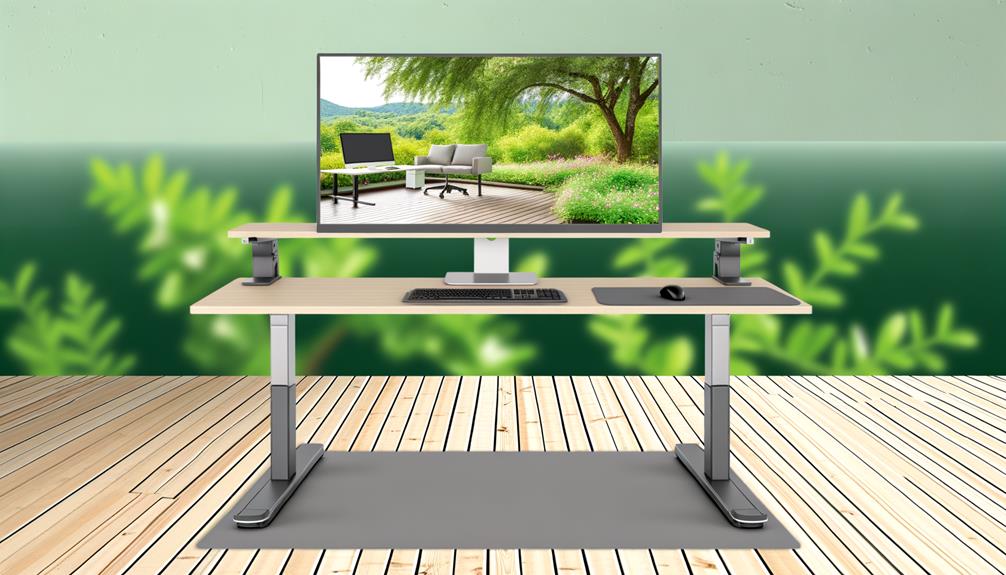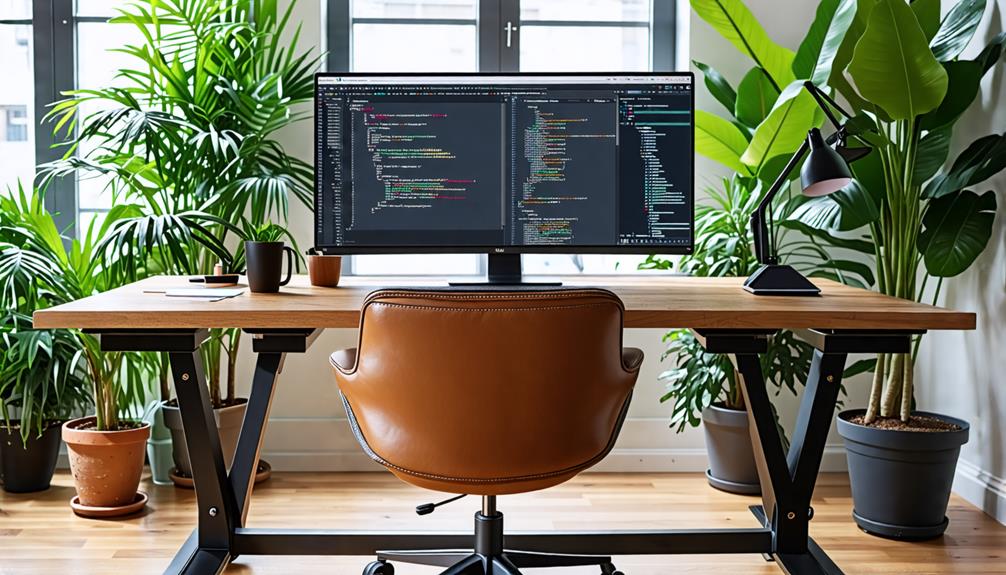Using a Standing Desk Like a Pro

To use a standing desk like a pro, you need to get the basics down. For a comfortable and ergonomic setting, keep your elbows bent at a 90-degree angle while typing, with the monitor positioned at eye level and your feet flat on the ground or on a footrest. Balance sitting and standing by alternating between the two every 20-30 minutes to avoid fatigue and maintain proper posture. Implement anti-fatigue mats and engage in stretching exercises to keep you moving. Finally, customize your workspace for maximum comfort by choosing an adjustable ergonomic chair, placing your keyboard and mouse at a comfortable height, and using a standing desk that promotes flexibility.
Basic Ergonomic Setup

Use a standing desk that allows proper posture and comfort by setting it up to meet your ergonomic needs.
Ensure that the desk height is adjusted so that your elbows are at a 90-degree angle when typing.
Your screen should be at eye level to prevent straining your neck, and your feet should be flat on the ground or on a footrest for stability.
Additionally, consider using an anti-fatigue mat to provide cushioning for your feet during prolonged standing.
Taking regular breaks to stretch and move around is also essential to maintain comfort and prevent fatigue.
Balancing Sitting and Standing

To guarantee a balance between sitting and standing while using your standing desk, alternate between sitting for one hour and standing for five minutes, gradually increasing standing intervals as your body adapts to avoid discomfort. This is essential as prolonged sitting is linked to health risks such as diabetes and heart disease.
Research supports that incorporating regular shifts between sitting and standing can mitigate these risks. To confirm a balanced approach, set a timer or reminder system to remind you when it's time to switch positions.
Once you're comfortable standing for five minutes, increase your standing time to 10 minutes. Incorporating short movement breaks, like walking or stretching, every 30 to 60 minutes will improve overall productivity and reduce fatigue.
As you establish a routine, use your standing desk for specific tasks or during virtual meetings to promote movement without sacrificing comfort. Over time, your body will adjust, and you'll find that your standing desk works in harmony with your natural need for movement to support your overall well-being.
Countering Fatigue Techniques

For ideal energy levels and comfort, you should implement a variety of counter-fatigue techniques while using your standing desk. One key approach is to incorporate short walking breaks every 30 minutes to counteract fatigue and improve circulation. This regular movement can greatly enhance your focus and overall productivity.
To further alleviate discomfort, consider using anti-fatigue mats to reduce pressure on your feet and legs during prolonged standing. These mats promote subtle movements that can combat fatigue.
| Technique | Benefits | Frequency |
|---|---|---|
| Walking breaks | Improved circulation, focus, and productivity | Every 30 minutes |
| Anti-fatigue mats | Reduced fatigue and discomfort | Throughout standing period |
| Alternating sitting and standing | Prevents static positions, optimized energy levels | Every 20-30 minutes |
| Simple stretching exercises | Relieves muscle tension, stimulates blood flow | Every hour |
Additional methods to mitigate fatigue include alternating between sitting and standing every 20-30 minutes to prevent static positions and relieve muscle tension. Engage in simple stretching exercises or leg raises every hour to stimulate blood flow. Finally, stay hydrated by keeping a water bottle at your desk, as proper hydration is linked to improved energy levels and can help reduce fatigue during long periods of standing. By incorporating these techniques, you will optimize your energy levels throughout the day.
Posture and Causes of Strain

Maintaining proper standing posture while using a standing desk is essential to avoid strain and discomfort, as it helps to distribute the weight evenly and prevents muscle fatigue. You might be wondering if standing really makes a difference, but trust us, it does.
When you stand, your brain signals your muscles to work differently, protecting your back and neck from the risks of sitting. The key is to stand tall, with your feet flat on the ground and your monitor at eye level. This guarantees that you don't slouch or lean forward, which can put unwanted pressure on your neck and shoulders.
To make the most of standing, incorporate ergonomic accessories like anti-fatigue mats and supportive shoes to reduce strain on your feet and legs.
Don't be afraid to switch between sitting and standing every 20-30 minutes to avoid muscle fatigue. And remember, maintaining a proper posture isn't just about the standing position; it also applies to the sitting position.
Customizing Workspace for Comfort

You can take your newly refined posture to the next level by customizing your workspace for ideal comfort.
To create a comfort-focused workspace, follow these steps:
- Adjustable Ergonomic Chair: Verify your chair provides proper height adjustment and supports your sitting posture.
- Desk Mat and Cable Management: Use desk mats or anti-fatigue mats to reduce strain, and organize cords for a clutter-free workspace.
- Customizable Standing: Consider a standing desk that allows for flexible shifts between sitting and standing.
- Keyboard, Mouse, and Monitor Placement: Position your keyboard and mouse together at a comfortable height, and use monitor arms to maintain a natural line of sight.
Conclusion
Start using a standing desk effectively by following these practical tips.
Guarantee a basic ergonomic setup with your desk at elbow height, monitor at eye level, and a comfortable distance from your body.
Balance sitting and standing by switching every 30 minutes to avoid fatigue.
Employ countering fatigue techniques by moving regularly, and prioritize proper posture to reduce strain.
Customize your workspace for comfort, and make adjustments as needed to maintain your wellbeing and productivity.
Leave a Reply